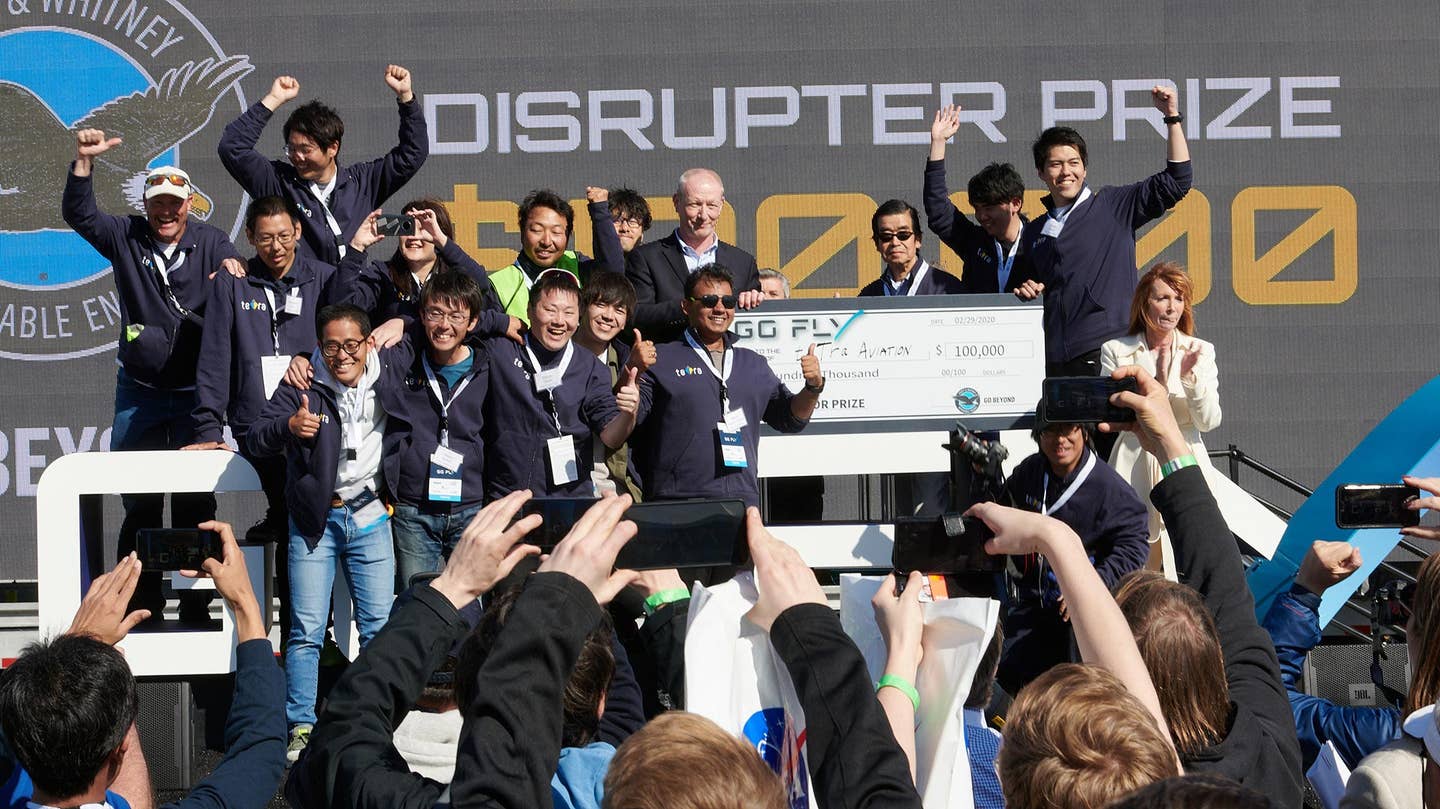
Members of teTra Aviation from Japan celebrate their GoFly Prize win. Courtesy Josh Robinson Studio for GoFly
The GoFly Prize is an innovation competition that hopes to be the catalyst for the creation of personal flyers as a first step towards transforming the future of transportation with flying cars, flying motorcycles, hoverboards, jetpacks, human-carrying drones, and other personal flyers. The challenge’s Final Fly-off was held on Leap Day (February 29) at Moffett Federal Airfield’s NASA Ames Research Center, with Team teTra of Japan winning the Pratt & Whitney $100,000 Disruptor Award.
Over the past two years, 854 teams comprising 3,800-plus innovators from 103 countries took up the GoFly challenge and have been crafting their machines and testing them as manned, mannequin-bearing, and unmanned machines.
The grand prize of $1,000,000 sponsored by Boeing is still unclaimed, as none of the team’s devices were capable of completing the required flight demonstration, conducting a speed run of six laps around a 1-nm course carrying a 200-lb payload, with endurance greater than 20 minutes followed by a descent to landing with a fuel reserve for 10 minutes of additional flight.
“Innovation has always been at the core of our DNA at Pratt & Whitney, and we applaud GoFly’s efforts to transform the industry,” said Geoff Hunt, senior vice president, engineering. “We’re proud to sponsor such an exceptional competition and we designed the Disruptor Award to recognize the team that challenged the status quo, delivered unique thinking into a complex issue and considered safety, reliability, durability and system integration.”
Prior to the Final Fly-Off, held at Moffett Federal Airfield during Leap Day, 10 teams were named Phase I winners and were awarded $20,000 prizes for their concepts, while five teams were named Phase II winners and were awarded $50,000 for their prototype submissions.While no team captured the Grand Prize title, GoFly looks forward to awarding that $1 million prize in the near future.
In order for Team TeTra to fly their winning entry in the United States, they first needed FAA certification, and a U.S.-licensed private pilot to fly it. The team chose Ben Grubb of Eugene, Oregon, as their pilot partially because Grubb had just completed the build of his Sonex Onex experiential airplane.
“The unique aspect of teTra’s 3 was that instead of having four flat rotors, they were banked at an angle,” Grubb explained. “The idea is that as you transitioned to forward flight, the forward rotors end up being horizontal and the majority of the power goes to the back rotors which turn into thrust, with a small wing generating some lift. It turned out we were hoping to fly it, but the batteries didn't have the power to lift someone. And when we finally got the aircraft flying, it was basically good for about five minutes and the requirement was 20 minutes plus the 10-minute reserve.”
While Grubb did not fly in the teTra 3, he was PIC at the controls. “It turns out I had to remotely operate it as a drone in the exhibition portion of the event. I’d flown other R/C aircraft and helicopters and was training on a drone simulator. It was just exactly like flying a R/C helicopter. Besides, all these new urban air mobility (UAM) vehicles only fly by computers—as a pilot you do not fly it so much as make suggestions as to where it should go,” Grubb said.
The five teams that qualified for the Final Fly-off at Moffett Field were:
DragonAir Aviation from the United States entered the final competition with their Airboard 2.0, an all-electric, heavy lifting, self-stabilizing, multi-copter that carries a single passenger in a standing position. Team Captain Mariah Cain is a trained hydroflight athlete and is the technician for the device as well as the team’s experimental pilot.
TeTra from Japan competed with their teTra 3 device, led by Tasuku Nakai, a doctoral student in the department of mechanical engineering at the University of Tokyo, studying the strength of materials, fracture mechanics, human injury assessment and structural design.
JAYU from the United States brought their unmanned, 250-lb aircraft, the JAYU Ray, to the Final Fly-off. Team Captains Ben Sena and Soojae Jung are based at the Massachusetts Institute of Technology (MIT). The team has a strong focus in aircraft design and is “dedicated to conquering the GoFly Prize and impacting an emerging industry catering to micro air transit.”
Texas A&M University Harmony is a US team that made the Final Fly-off with Aria, an all-electric high-TRL compact rotorcraft designed to minimize noise and maximize efficiency, safety, reliability, and flight experience. Team Captain Dr. Moble Benedict is an assistant professor of aerospace engineering and founder of Advanced Vertical Flight Laboratory (AVFL) with 15 years of experience in VTOL aircraft concepts.
VertiCycle from the US brought their Electric Jet Bike VTOL aircraft to the Final Fly-off. Team Captain Pete Bitar has been dreaming about and working toward personal, VTOL flight for almost 40 years after buying a “Space Ranger Jet Flying Platform” out of the back of a Popular Science magazine at age 13.
While the UAM technology may not be ready for prime time yet, Grubb sees a big future for the sector. “When this sector gets going, it is going to overtake general aviation because the cost of entry is so low. The general consensus at the event was that while there are currently no certified manufacturers for this type of equipment, everybody needs to get ready for this new wave of aviation, it’s only a matter of time now for battery technology to make it all possible,” he said.

Sign-up for newsletters & special offers!
Get the latest FLYING stories & special offers delivered directly to your inbox






